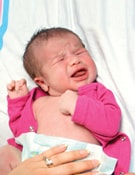Content on this page was developed during the 2009-2010 H1N1 pandemic and has not been updated.
- The H1N1 virus that caused that pandemic is now a regular human flu virus and continues to circulate seasonally worldwide.
- The English language content on this website is being archived for historic and reference purposes only.
- For current, updated information on seasonal flu, including information about H1N1, see the CDC Seasonal Flu website.
Caring for Someone Sick at Home
Check for Fluid Loss
December 5, 2009, 6:00 AM ET
Use this list to check for dehydration:
- Make sure babies have wet diapers. Check that wet diapers
are as frequent and heavy as normal.
- Look for tears when the baby or toddler is crying.
- Check to see how wet the child’s mouth is. The inside of the mouth should be wet. Wash your hands after you do this.
- Check to see that children, teens, and adults are making frequent trips to the bathroom to urinate.
- Check the urine color. Clear or light yellow-colored urine means the person is getting enough fluid. Dark yellow urine signals the person is dehydrated.
Get email updates
To receive weekly email updates about this site, enter your email address:
Contact Us:
- Centers for Disease Control and Prevention
1600 Clifton Rd
Atlanta, GA 30333 - 800-CDC-INFO
(800-232-4636)
TTY: (888) 232-6348 - Contact CDC-INFO
 Download & print this entire guide
Download & print this entire guide

